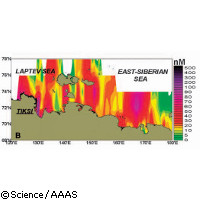Researchers warn of how methane leaks affect planet
An international team of researchers has discovered some alarming news: a section of the Arctic Ocean seabed holding extensive stores of frozen methane is displaying signs of instability and widespread greenhouse gas leaks. The study's findings were recently published in the journal Science. The researchers from Russia, Sweden and the US observed perforations in the permafrost under the East Siberian Arctic Shelf that are allowing substantial amounts of methane to escape into the atmosphere. The release of even just a small amount of the methane stored in the shelf could result in further climate warming. 'The amount of methane currently coming out of the East Siberian Arctic Shelf is comparable to the amount coming out of the entire world's oceans,' explained lead author Dr Natalia Shakhova of the International Arctic Research Center (IARC) at the University of Alaska Fairbanks in the US. 'Subsea permafrost is losing its ability to be an impermeable cap,' she warned. So what's worse? Carbon dioxide (CO2) or methane? Experts say methane wins hands down because it is 30 times more potent than CO2. According to the researchers, the carbon-containing organic material starts to decompose and slowly releases methane when it begins to thaw in the permafrost. Not only can these releases be larger than those triggered from decomposition, but they can also be a lot more sudden and unexpected. An area that encompasses over 2 million square kilometres of the Arctic Ocean seabed, the East Siberian Arctic Shelf is rich in methane, making it one of the world's greatest sources of this chemical compound. A breakdown of the study's findings shows that the East Siberian Arctic Shelf emits 7 teragrams (1 teragram equals 1.1 million tonnes) of methane each year. This amount is similar to what is emitted from the rest of the planet's oceans combined. 'Our concern is that the subsea permafrost has been showing signs of destabilisation already,' Dr Shakhova said. 'If it further destabilises, the methane emissions may not be teragrams, it would be significantly larger.' According to the scientist, the Earth's geological record shows variances in atmospheric methane concentrations: around 0.3 to 0.4 parts per million during cold periods to 0.6 to 0.7parts per million during warm periods. Average methane concentrations in the Arctic currently stand at around 1.85 parts per million, which is a record for the last 400,000 years. Even more disconcerting is the fact that the East Siberian Arctic Shelf is reporting concentrations that are even higher than that. The researchers said the shelf is only up to 50 metres in depth, and does not release methane during the planet's coldest periods; it remains a frozen arctic coastal plain. But the warmer the Earth becomes, the higher the sea levels rise, which leads to the shelf being flooded with seawater. Experts say seawater is 12 to 15 degrees warmer than the average air temperature. 'It was thought that seawater kept the East Siberian Arctic Shelf permafrost frozen,' Dr Shakhova said. 'Nobody considered this huge area.' Past studies in Siberia spotlighted methane venting from thawing terrestrial permafrost. But thanks to earlier work carried out by co-author Dr Igor Semiletov, who joined IARC as the visiting scientist from the Pacific Oceanological Institute, Far Eastern Branch, Russian Academy of Sciences, researchers in the 1990s became aware that the amount of methane being emitted from terrestrial sources decreased at higher latitudes. However, those studies went no further from the coast. Drs Shakhova and Semiletov, along with their colleagues, decided to take their research offshore from 2003 to 2008. Their investigation helped them determine that methane levels were elevated overall and that the seascape was home to over 100 hotspots. They also found that methane gas trapped under and in the sea ice was not only being dissolved in the water, but was also escaping into the atmosphere. 'The release to the atmosphere of only 1% of the methane assumed to be stored in shallow hydrate deposits might alter the current atmospheric burden of methane up to 3 to 4 times,' Dr Shakhova said. 'The climatic consequences of this are hard to predict.'
Countries
Russia, Sweden, United States



